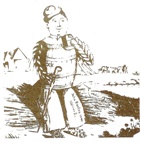The relationship between individuals and the community within the tripartite intersubjectivity is a complex one, for, in order for it to reflect folk society, the presence of the individual has to be subsumed within her/his expression and her/his audience. Expressing a personal narrative involves setting oneself above the crowd, whilst the further an individual stands above or apart from those seeking a representative, the less they epitomise folk society. It forces us to ask the question, 'can there be such a thing as a folk hero'?
Orton, Westmorland, although only a tiny village close to the Pennines, boasts its own Liberal Club, opened in 1888. The plaque speaks of community pride, but features an individual - Party leader, William Ewart Gladstone - in a head and shoulders view, surrounded by what appear to be wild flowers such as dog roses. He holds the legend which ties the Party leader to a folk community of local people. Thus the plaque roots the individual, who would otherwise be distinguished from his audience by hierarchy, education, social status and geography, within the community and within expressions of both landscape and built environment. |
| John Lilburne, prolific pamphleteer of the mid-seventeenth century, retains an iconic status. As 'Freeborn John' his life forms the subject matter of a folk album, composed by Rev Hammer, which was performed, along with detachments from the local Sealed Knot society, at the 2006 Beautiful Days festival. In his lifetime he was the author of numerous pamphlets, some of which are part of a corpus of anonymous literature associated with the Leveller movement, and some of which bear his name, image, and advertise his personal battle with authority. The public trial - the legal process being both theatre in which the one speaks for the many, but also a forum in which the many are excluded - often provides the context for the individual's attempt to separate the judicial process from the people, whilst s/he speaks for the people, but in setting the individual apart from the public forum, the constant danger is that individual self-publicity will distance a 'folk hero' from those s/he represents. | |
 |
One means to blur the distinction between individual and community is to reverse the process: start with community values and then construct a individual to represent them. These can attempt to encapsulate national values, such as in the figures of John Bull or Britannia, or can be allegorical, such as the the literary 'everyman', or we might also include historical characters through the process of mythologising - Robin Hood, Dick Turpin. The best examples of this process come from the relationship between English people and their ale. The figure of John Barleycorn is given a name; the traditional song narrates the life of the crop as if it were an individual: ploughed in, sprouting anew in spring, growing and developing a beard, being cut off at the knees, bound, threshed, re-emerging triumphant as the beer which is the enabler of folk society. A similar process turns a beer jug into Toby Fill Pot, to Fillpot to Philpot. Toby Philpot was the heroic subject of a popular song of 1761, which was turned into a commercial proposition by Staffordshire potter, Ralph Wood, and then popularised by Royal Doulton, mass producers of Toby Jugs, and in the nineteenth century a range of character jugs. Featured left is a Royal Doulton John Barleycorn mug. |